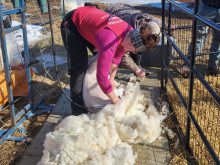A recipe of rendered cattle meat and bonemeal can produce almost as much energy as coal without the harmful emissions, says a University of Saskatchewan agricultural engineer.
“The biggest bang for the buck” will come from research into how to manage the 25 percent of animal remains that are left over after rendering, Terry Fonstad told the 2007 Saskatchewan Beef Symposium held in Saskatoon on Feb. 7.
“We as an industry have to make sure we handle our deads in a sustainable way.”
He the industry has been looking for new ways to deal with dead animals, prompted by consumer demands for safe food, movements away from feeding animal parts back to animals and the risk of prion material.
Read Also

Charges laid after cattle theft
Saskatchewan RCMP lay two charges against a man after six cattle went missing.
Fonstad said the gasification of meat and bonemeal not only reduces the use of fossil fuel but eliminates the need for a truck to haul the animals away or a landfill in which to dump them.
In the two-year study that began last year, cattle remains are heated and dried to produce an assortment of gases that can be harnessed for energy. Similar work is underway in Spain and the United Kingdom.
Fonstad said the gasification process could use the energy from these rendered products on site and put energy back into the rendering process.
The remaining ash and its phosphorus content could also be used for soil amendments or waste water treatments, but Fonstad said further study is required.
“If we add value to it, then it’s worth hauling it somewhere and we don’t landfill it,” he said. “Now we’ve got sustainable production.”
Fonstad cited studies that have shown heating the waste to 850 C for two seconds kills harmful organisms such as prions.
He said burying animals on the farm is not sustainable because of risks from prions that can live up to 10 years.
An earlier symposium session discussed disease problems that can lead to sick and dying cattle that end up at rendering plants.
John Campbell of the Western College of Veterinary Medicine said while accidents, bloating and other causes kill cattle, respiratory diseases remain the most prevalent. Chronic pneumonia polyarthritis syndrome as one of the worst, he added.
The syndrome is difficult to treat and control and may be able to survive in the environment, he said, raising questions about the safe disposal of animals that have succumbed to the disease.
“There’s lots we don’t know about it.”
















